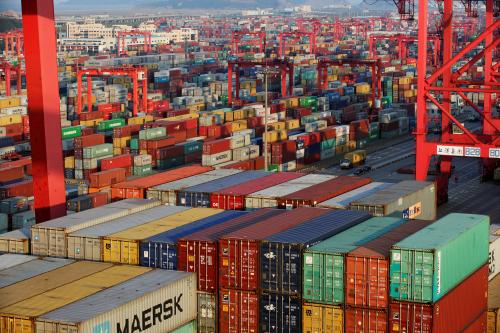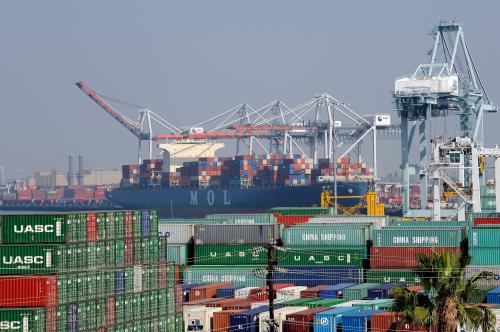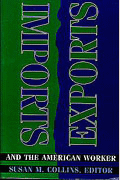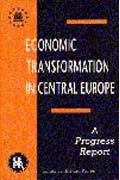Content from the Brookings Institution India Center is now archived. After seven years of an impactful partnership, as of September 11, 2020, Brookings India is now the Centre for Social and Economic Progress, an independent public policy institution based in India.
This article first appeared in the Mint.
The proposed border tax adjustment policy deviates from the conventional WTO-consistent regime.
US President Donald Trump is expected to announce his new tax policy, with lower corporate tax and a border tax adjustment (BTA) scheme. In addition to recent Bills pertaining to BTA introduced in the US Congress, the Republican Party’s House leadership has introduced its own vision of tax reform for the US, with recommendations for a consumer-based tax and increasing the presently low US reliance on indirect taxes in comparison to other countries.
This is because the World Trade Organization (WTO) allows governments to remit indirect taxes (but not direct taxes) back to the exporter. Under this scheme, the consumption-based (indirect) tax would be remitted for exports but not for domestic sales. The Republican Party’s vision document states: “This Blueprint eliminates the existing self-imposed export penalty and import subsidy by… providing for border adjustments exempting exports and taxing imports, not through the addition of a new tax but within the context of the transformed business tax system. The Blueprint also ends the uncompetitive worldwide tax approach of the United States, replacing it with a territorial tax system that is consistent with the approach used by our major trading partners.”
However, some major trading partners are reportedly preparing a WTO challenge to the US BTA regime. WTO members are supposed to meet the required disciplines in the WTO, both those specific to BTA and others such as non-discrimination provisions embodied in national treatment and most favoured nation (MFN) conditions. There are grounds to question the WTO consistency of the proposed BTA scheme, providing a basis for retaliation by others against US trade. By some estimates, this retaliation could be a historical high at $385 billion.
Details of the proposed BTA are not yet clear and have generated diverse views. Within the US Congress itself, ways and means committee chair Kevin Brady has emphasized that the scheme would be consistent with WTO requirements while senate finance committee chair Orrin Hatch has questioned if the proposed BTA is WTO-inconsistent and will lead to consumer price increases and undue costs on certain industries. Some BTA features suggest that its implications would be far more complex than even what Senator Hatch is concerned about.
Under WTO rules, remittance is allowed only for certain specified indirect taxes on exported goods. For instance, remission of taxes in inputs used in the process of production for exported goods is allowed but not tax on capital or labour cost encompassed within a consumption-based tax. Likewise, corporate tax exemption for exports would be WTO-inconsistent.
Some of the ideas for implementing the BTA include imposing an import tax equivalent to the taxes remitted by the country exporting to the US, or to have an import tax of a specified percentage. Different countries do not remit the same amount of tax on a particular product, nor is the tax remitted by any country on different products the same. In such a situation, imposing taxes equivalent to amounts remitted by other countries would be a huge enterprise and risk breaching the WTO’s MFN provision which requires the same treatment for all members, unless justified in terms of another WTO provision. Likewise, an import tax of a specified percentage would breach tariff binding agreed to by the US within the WTO.
Another idea is to treat imports less favourably than domestic products once the former enters the domestic market, which would violate the WTO national treatment requirement. Yet another plan is to implement the policy over a transition period. However, the WTO challenge could come the moment the policy is initiated.
Further complications of the BTA are reflected by the divisions among US businesses. A large group of retailers and importers against the BTA is pitted against a group of exporters in favour of the scheme. There are also contrary views on whether the BTA scheme would increase domestic prices.
It is agreed that the immediate effect of higher import taxes would be to increase domestic prices, but some say that this would over time result in a higher value of the dollar, thereby reducing the price of imported goods. This argument does not fully consider the effect of dollar appreciation on US export performance or its global value chain links, and the fact that exporters to the US could adjust their prices upwards in the new situation. Even if the US dollar appreciation reduces the import prices over time (which may be long), the adverse impact of price rise during the transition period will need to be addressed.
Some have said that the US could walk away from the WTO. This will have huge adverse implications. The US uses the WTO system intensively and gets several benefits, including improved predictability and sales of its own exports; ironically, an important aim of the BTA is to increase the sales of US exports.
In a world with international supply chains, the adverse knock-on effects for US and others could be large. Further, the linked foreign policy implications of a bilateral transactional approach being emphasized by the US would be unimaginably negative for all concerned, including the US.
Clearly, the proposed US BTA regime has complex implications. Special care is needed to assess the benefits and costs of deviating from a conventional WTO-consistent regime applied by several countries.
The views are of the author(s).










Commentary
Op-edTrump’s new trade tax in uncharted territory
March 1, 2017